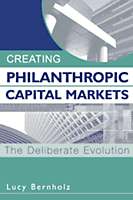How should philanthropists think?
Stanford has a new School of Design, the d.school. Despite the ultra-hip lower case school name, there are some interesting things going on there, led by an important cross-discipline group of people. Right now you can check out some of the stuff in one of these new online conferences (that I love - no airport security involved!) called AlwaysOn.
David Kelley of IDEO is one of these folks, and this interview with Business Week shows what he's trying to do. I've excerpted the bit I think is most relevant to philanthropy:
Q: The D-school is still in formation, right?
A: ...The big difference is the faculty and students come from different departments: business, humanities, engineering, so forth. We all work on projects together. In the past, group projects would be done by a group of designers or a group of engineers. With engineers, whatever the problem is, a mechanism is probably the outcome. If it's all businesspeople, the answer is always a spreadsheet or a chart with 2 by 2 matrix. Now we have all these different disciplines, and it's not predictable where the innovation is going to go and that's what's exciting.
Q: Are you seeing any trends?
A: The solutions are more integrated, taking into account technology, business strategy, the user interface. I would say the solutions are more human. There's also an amazing discontinuity as far as what students are interested in. Ten years ago, most of my students wanted to be Bill Gates, do a startup, and become wealthy. They're still entrepreneurial, but they're in my office saying, "I want to do something that has social value."
Those student interests have driven our research agenda -- sustainability, superlow cost for the developing world, K-12 education, health and wellness, and medical stuff."
This kind of cross-discipline, cross-sector thinking is key. Its hard to find places to practice it. Maybe the d.school could help. Its almost cool enough to make me want to go back to school. Almost.
Bookmark this on Del.icio.us




